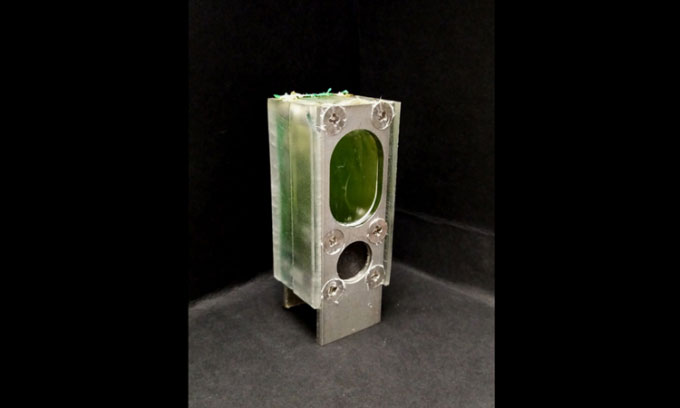British scientists develop a computer that runs on cyanobacteria in 6 months
Scientists have developed a power supply system for computers that includes cyanobacteria in a sealed container the size of an AA battery.
Christopher Howe at the University of Cambridge and colleagues operated a computer for six months powered by cyanobacteria. The new study was published in the journal Energy & Environmental Science on May 12.

The system contains cyanobacteria that power the computer.
In the study, the cyanobacteria Synechocystis sp. PCC 6803 - commonly known as cyanobacteria, which can produce oxygen through photosynthesis when exposed to sunlight - comes in a sealed box about the size of an AA battery made of aluminum and clear plastic.
A computer is placed on a window sill at a research team's house during the Covid-19 lockdown from February to August 2021. During this time, a battery made from cyanobacteria provided a constant current through the anode and cathode to operate a microprocessor.
The computer operates on a 45-minute cycle. The team used it to sum consecutive integers to simulate computational work, which requires 0.3 microwatts of power, and 15 minutes of standby, which requires 0.24 microwatts. The microcontroller measures the device's output and stores this data in the cloud for the research team to analyze.
There are two potential theories about the power source, says Howe. The first is that the bacteria themselves produce electrons, which in turn generate an electric current. Second, the bacteria create the conditions that cause the aluminum anode in the box to corrode in an electron-producing chemical reaction. The test was conducted without appreciable anode wear. Therefore, the team believes that the bacteria produce most of the electric current.
According to Howe, the new method could scale up adoption, but more research is needed to determine how much. He said placing a device on the roof would not provide enough electricity for the household. But the device will be useful in rural areas of low- and middle-income countries, or with jobs where a little power can be useful, such as environmental sensing or mobile phone charging.
The bacteria make their food when they photosynthesize, and the battery can continue to produce electricity even after dark. The researchers suggest that this is due to bacteria that process excess food.
The team believes that effective devices can be made cheaply and that commercial application will be possible within five years. They have also found other algae that generate stronger currents, and claim similar photosynthetic generators could become the source of power for many small devices in the future, without the need for such objects. rare and unsustainable materials in batteries.
- Ancient bacteria cause global danger to re-export and develop
- Poisonous algae cover 1.5 km of Chinese lake
- Cyanobacteria can power small electronic devices
- Found oxygen stored by bacteria in fossil samples 1.6 billion years ago
- Embryo production of teratogens - Contrary ideas
- British scientists develop an invisibility shield that can hide any object - VN Intelligence
- The origin 'no one knows - no one knows' in the names of the months
- Computer virus: Looking back 20 years
- The origin of the computer mouse
- Computer memory with crystal
- Bacteria can see things like people
- Control the computer with thoughts
 The US company is about to build a supersonic passenger plane of 6,000km / h
The US company is about to build a supersonic passenger plane of 6,000km / h Japan develops avatar robot as in fiction film
Japan develops avatar robot as in fiction film Australia tested the world's first mango picking robot
Australia tested the world's first mango picking robot America develops technology to separate water from animal waste
America develops technology to separate water from animal waste